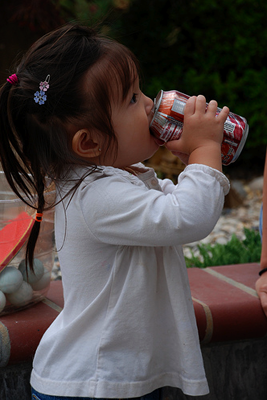Life Cycle is a series of posts that looks at the environmental impacts of everyday things.

Last week we talked about popcorn. Chemically flavored, over-packaged, jacked-up-corn-crop-derived popcorn. Now we reach for one more corn-related product to round out our Blockbuster night: soda.
The corn relationship might not be immediately apparent. What does a bubbly liquid, the color of molasses and contained in flashy aluminum graphics, have to do with stalks and cobs and kernels?
For about the last 20 years, regular soda has been sweetened with high fructose corn syrup - a
corporate money-saver many people believe is recipe for diabetic disaster but might not consciously associate with the crop whose name it bears.
High fructose corn syrup (HFCS) indeed begins with corn - with the help of genetically modified enzymes, cornstarch yields glucose, which is processed to yield higher fructose content. HFCS is in everything from pop to bread to spaghetti sauce to granola bars, and Americans now consume more of it than they do cane sugar. Our food supply's tremendous reliance on corn crops is largely due to HFCS, as well as grain feed for livestock and many other uses. (As we mentioned last week, rising corn prices in the midst of the ethanol craze affect more than tortilla prices.)
The average American drinks 50 gallons of soda each year, far outreaching milk, bottled water or even alcohol consumption. Globally, carbonated soft drink sales are to the tune of $200 billion; the industry's profit margins are notoriously high and center on a product with no nutritional value. Yet, we keep on guzzling. Or, as Ani DiFranco put it, "we're led by denial like lambs to the slaughter/ Serving empires of style and carbonated sugar water." (You may pause here for an Ani-related, rum-and-coke college flashback.)
Beyond soda's links to the corn supply, its environmental impacts are many. Ponder them, and then consume smartly:
1. Aluminum soda cans: Aluminum ore is strip-mined from surface land; next, the aluminum extraction process occurs in smelters, massive containers that require massive power. Each year, the aluminum industry uses as much electricity as the entire continent of Africa. The one benefit is aluminum can be recycled over and over again without degrading, so it you must guzzle it, make sure your can gets recycled. Yes, we know recycling also takes energy, but let's not get too carried away.
2. Plastic bottles: Mountain Dew bottles have a habit of seeping toxins into our earth and water supply once they hit the landfill. See our posts on yoga mats and Styrofoam to learn more about plastic as an eco-villain. Anyone thinking they can assuage their guilt by dewing it to the recycling bin, consider this. Plastic (unlike aluminum) does downgrade. Every time your plastic bottle gets recycled (if it gets recycled - most municipalities recycle just a few grades of plastic) it breaks down into a lower grade plastic. It will end up in a landfill sooner or later (later is better, try to get some extra life out of it).
3. Delivery: As with many products, the race to meet demand on grocery store shelves requires a lot of diesel-fueled semis hauling a lot of inventory down the highway.
4. Empty calories: Soda consumption is linked to obesity, a modern epidemic with its own countless environmental repercussions.
5. Fake sweeteners: While diet sodas don't include HFCS, their artificial sweeteners have been scientifically linked to health ailments from leukemia to memory loss, from weight gain to fibromyalgia.
There are signs that soda consumption has peaked, perhaps due to increasing wariness of HFCS. Companies offering sodas sweetened with cane sugar or altogether organic soft drinks are growing, and even PepsiCo this year released Pepsi Raw - containing stuff like cane sugar, coffee leaf, apple extract and tantaric acid from grapes - in the UK.
Maybe the soda bubble is bursting. If not, make ours a Pepsi.
Next week we head from the living room to the bedroom. Meow.
This post was written by Sarah Smarsh and Simran Sethi. Thanks to the University of Kansas School of Journalism, Lacey Johnston and Merete Mueller for research assistance and sabellachan for the image.